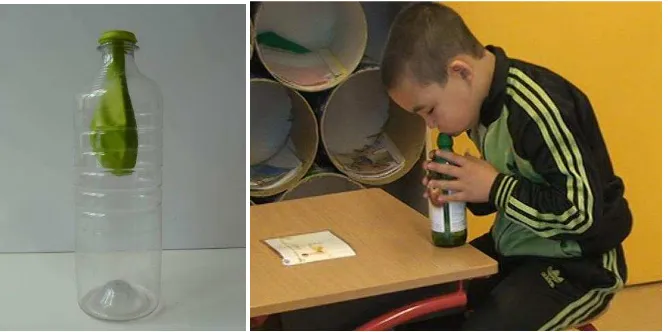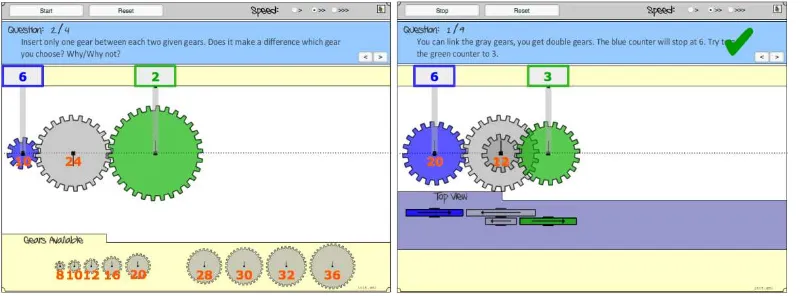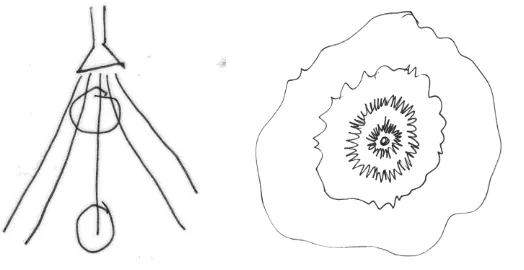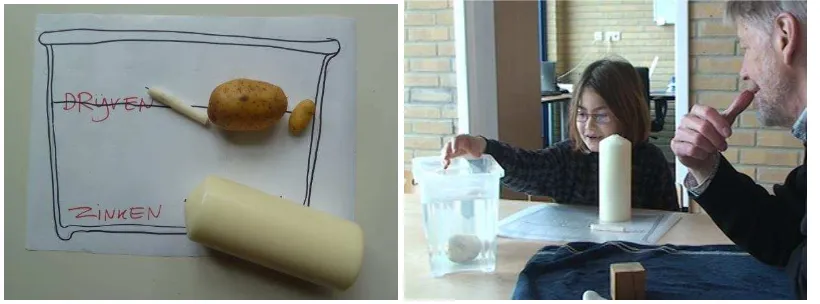DESIGNING FOR SCIENCE EDUCATION AND MATHEMATICS EDUCATION
Frans van Galen
Freudenthal Institute for Science and Mathematics Education (FISME), Utrecht University, The Netherlands
Abstract
Science education and mathematics education at the primary level are compared in order to discuss to what extend integration between the two is possible and desirable. They have in common that both can be founded on inquiry learning and that understanding children s thinking forms the basis for designing learning trajectories. Some examples of how science and math teaching can be combined, and how the two could profit from each other are given. The topic of floating and sinking is discussed, to underline that science and mathematics ask for their own local instruction theories.
Keywords: inquiry based learning, guided reinvention, local instruction theories, learning trajectories
INTRODUCTION
In the new curriculum for Indonesian primary schools choice is made for the integration of school subjects and one of the decisions has been to suspend science as a separate subject. In the Netherlands science is still a separate school subject, but several projects investigate the possibility of combining science with language and mathematics. One of the motives is that there is so much pressure on the Dutch schools to perform well in mathematics and language that science risks to be neglected; by combining science with these subjects, it could get more attention. With my colleagues I have been investigating the combination of science and mathematics with another motivation: the combination with science could bring a spirit of inquiry learning that is missing too often in mathematics teaching.
In this contribution to the SEA-DR conference I want to compare science education on the primary level with mathematics education and discuss to what extends integration between these two is possible and desirable. First I shall compare mathematics teaching and science teaching and discuss what they have in common. Then I shall discuss some examples of how science and math teaching can be combined, and how they could profit from each other. The last part of this paper is meant as a warning not to neglect the specific nature of science and mathematics. Whether or not they are combined in the same lesson, science and math are different subjects and should be treated as such.
COMPARING SCIENCE AND MATH EDUCATION
If we look around in schools, however, the general impression is that there is not much inquiry in most lessons. This applies to both Indonesia and the Netherlands, even though there are many differences between these countries in the way mathematics is taught. In science education the situation appears to be the same; it is much more common that the teacher explains phenomena than that children try to formulate explanations themselves. Teachers like to explain things - that is probably why they have wanted to become a teacher - and there is a lot to explain in science, but this is only part of the story: in every topic there are opportunities to let children experiment and come with their own explanations. If the children are actively constructing knowledge they will learn more than when they are just passive listeners.
Figure 1a and 1b. It is impossible to inflate a balloon inside a bottle.
An example from a series of lessons in grade 2 about air and wind may illustrate this last point. We gave children a balloon that was put inside a bottle, with the opening of the balloon over de the top of the bottle, and asked the children to inflate the balloon (figure 1a and 1b). The children worked in pairs and they all got intrigued by the fact that inflating the balloon proved very difficult. It is, in fact, impossible, because there is air inside the bottle that also occupies space. Some children spent one hour or more to try out different solutions: using a pump, stretching the balloon (as they thought it was too stiff), or blowing through a reed. While experimenting some children tentatively came up with an explanation: there is air in the bottle and that air pushes back against the balloon. This explanation was discussed with the group and the other children agreed that this was indeed a plausible explanation. Interestingly, one of the children told that they had already tried a solution that took this into account: they had tried to pump out the air - with a device for pumping air out of a wine bottle - before putting the balloon into the bottle. A fellow student could explain why this had not worked: the air goes back into the bottle superfast .
Within Realistic Mathematics Education guided reinvention is an important principle for designing learning trajectories. We should offer children, as much as possible, the opportunity to reinvent mathematical concepts and procedures by themselves. Guidance is necessary, however. The lessons need carefully chosen problems that will elicit the intended discussions. The teacher acts as a well informed discussion leader and makes sure that conclusions are shared by all. A similar principle forms the foundation for inquiry based learning in science. The children should be offered the opportunity to formulate their own explanations for carefully chosen problems and experiments. The teacher should help children to build new understanding on the concepts and ideas they have already developed.
This makes guidance is a core concept in RME. The teacher does not passively wait and see what children will discover, but has clear ideas about which concepts are to be developed and plans the discussions meticulously. Teaching in the spirit of RME is more difficult than traditional teaching, because the teacher will never know for certain what is going to happen. She listens to the children, tries to understand their thinking, and reacts to that. If lessons have been tested carefully, however, it is possible to predict to some extend how children will react and to set up a so-called hypothetical learning trajectory Gravemeijer & Cobb, 2006; van Eerde, 2013), for a series of lessons.
Guidance is equally important in science education. Learning activities should be planned carefully and help children develop specific concepts; it is not enough if children are actively engaged and enthusiastic. So if the lesson series is about air and wind, a local instruction theory (Gravemeijer & Cobb, 2006; van Eerde, 2013) is necessary that specifies what informal ideas children may already have about air, why understanding air may be difficult and how the designed activities may contribute to children s growing understanding.
COMBINING SCIENCE LESSONS AND MATHEMATICS LESSONS
There are many opportunities to combine science lessons with mathematics lessons. Some topics lie on the border of math and science, like the geometry of vision: vision lines, standpoint, mirrors (Van den Heuvel-Panhuizen, 2008). Other topics are basically science, but involve mathematical tools. Graphs are a clear example. Carrying out science experiments can be used to develop understanding of such tools.I shall shortly discuss two examples that combine science and math. Other examples can be found in van Galen and Jonker (2013).
Gears are a standard topic in science lessons. Children are given plastic cogwheels and asked to experiment with combining them. In science lessons one often seems satisfied with some general conclusions about the speed of the wheels and the direction in which they turn, but the topic of gears is essentially about proportions and students may study these proportions in detail.
Figure 2aand 2b show the screens of a computer program we have designedi. The first
cogwheel is present at the start, but children are given a free choice in the wheels they put second or third. Or, they may even make a longer train. When the play-button is pushed the wheels start to turn and two counters keep track of how often the first and the last wheel make complete turns. Assignments for the students are, for example, to choose a series of wheels in which the last one will have made 24 turns if the first one will stop after 8 turns. Another assignment is to investigate how the size of wheels in the middle will affect the relation between the first and last wheel. There are also tasks in which the students can put two wheels on the same axis and investigate the effect of that.
A second example comes from a series of lessons in which students were given a sensor to measure light intensity. The sensor we used was connected to a computer but nowadays any iPad or smartphone can be easily turned into a light meterii. In the first
lesson we explained how the sensor worked and we let children experiment with it. We then asked them to formulate questions related to light intensity. One of the recurring questions was, as we had expected, why the measured light intensity decreases with the distance between sensor and lamp. We asked children in a second lesson to focus on that question and to measure light at different distances. The data should be plotted in a graph, but the children were free to choose their own kind of graph. This resulted in useful graphs like figure3a, but also in graphs like 3b, in which all measurements have been plotted in the actual order they were made. In the lesson that followed all graphs were compared, which led to a discussion about the axes, the scaling, and the choice for a bar graph or a line graph.
Figure 3a and 3b. Graphs for the data on measured light intensity.
There is, of course, also geometry in the question why the light intensity decreases so steeply with distance, and not in a linear way. It has to do with the fact that if the distance is doubled, the light will be spread over an area that is four times bigger.
Figure 4a and 4b. Drawings that illustrate why light intensity decreases with distance.
Within this school project many aspects of the science of light were discussed: what is light? How does it travel Why have the objects around us different colors? And so on. At the same time the children did learn mathematics. They used graphs for interpreting real data, not for numbers in their mathematics books. They used geometry to explain real phenomena, maybe even without realizing that they were using geometry.
SCIENCE NEEDS ITS OWN LOCAL INSTRUCTION THEORIES
Although it is possible to design activities that combine topics of both mathematics and science, these school subjects are different enough to merit an independent position in the curriculum. Science topics need their own local instruction theory, with hypothetical learning trajectories that describe how these topics may be taught. Such a trajectory should include a description of the goals of the lesson series, the presumed pre knowledge of the students, and a description of the educational activities. The foundation for any design should be an analysis of what children will know already and what may be difficult for them.
The example I will present comes from lessons on floating and sinking.Within the limitations of this paper I can only give an example of the analysis of the preknowledge of children, without describing the lessons that were developed. The example illustrates, however, that any topic in science - just like any topic in mathematics education - need its own, specific analysis. It also shows that science concepts are different from mathematical concepts
Figure 5. Laura s predictions for the floating and sinking test.
The four objects were: a big potato, a small potato, a big candle and a small candle. There was also a container with water on the table. To show her predictions Laura was asked to put the objects on a drawing of the container, either near the bottom, where the word zinken sinking was written, or near the line that represented the surface and where the word drijven floating was written see Figure 5 . After she had stated her predictions the objects were put into the water, one by one, and after each step Laura was asked if she wanted to change her predictions for the remaining objects. Notice that any adult who has cooked potatoes will know that potatoes sink, but in general a young child does not have this experience. Neither could Laura know beforehand that candles would float. What we wanted to know was if she would order the objects by material potatoes vs. candles or weight big vs. small . Laura s predictions were that the potatoes and the small candle would float, but that the big candle would sink. These predictions do not form a clear pattern, as there is no clear relation with material or weight.
The first object we put into the water was the big potato, and it sank. This did not give Laura a reason to change her other predictions. After she had seen, however, that the small potato also sank, Laura changed her prediction for the small candle; she now predicted that both candles would sink. When she saw that the small candle floated, however, she remained sure that the big candle would sink.
Laura is a quite smart child, but her final predictions were all wrong and she clearly showed her surprise - and disappointment. After she has seen that the big candle floats, she comes with a nice explanation, however:
Laura: Because it is big. And it is of the same material. This the big candle floats, and that the small candle too. She puts the small candle into the water)
Researcher: So how come ... )t is not only about how heavy this is, because this candle is really heavy, and this one is really light. You say it is the same material, what difference does that make?
Laura: Um ... Candle is light. So all the candle wax there is in the world ... unless there is iron put into it ...should sink.
It is not so surprising that Laura eventually offers the explanation that it is the material that makes the candle float, because in earlier lessons the children had observed that objects made of wood - a different material - will also float always, even big and heavy pieces of wood. What is most interesting, is how difficult it is for Laura to accept that a big candle may float.
What makes reasoning about floating and sinking so difficult? It may be true, like Piaget (1927/2001) says, that children have to be 9 years or older before they can understand the full scientific explanation. But is some partial understanding possible? At least children should be able to differentiate between light and heavy materials, to see that large objects may be light compared to their size , and that small object may be heavy compared to their size .
To understand why floating and sinking is difficult we should analyze what experiences children have gained already, and see how floating and sinking fit into these experiences. In other words, we should try to reason from the standpoint of a child. In their daily life children have gathered experiences that do not prepare them well for understanding floating and sinking. These experiences will have led to notions like the following.
Bigger things are more heavy. Generally speaking this is true: in daily life most big objects are heavier than small objects, whatever the material they are made of. The exceptions to this general rule - like a small piece of iron, or a large piece of Styrofoam - often lead to amazement by young children. It is not surprising, therefore, that the children in our lessons often did use big and heavy in the same breath, and also small and light . We heard them say things like: )t is big and heavy, and therefore it sinks , or )t floats, because it is light and small . These children knew the distinction between size and weight, but because the two go hand in hand so often, it was hard for them to keep them separated in their thinking.
To lift something heavy, you need more power. In daily life it seldom matters how big the things are that you want to lift: you will use two hands to lift a brick of 1 kilogram or a wooden beam of 1 kilogram, and the fact that the beam is bigger hardly matters. So if children see the water as lifting the floating objects, why should they expect that in that case the size of the object does matter indeed? This may explain why we see so often that children only focus on weight, and neglect volume.
Small objects pierce through things; big objects will be stopped more easily. In contrast we also saw how children sometimes focused on form and size, and neglected the weight of objects. This led to opposite predictions: small objects will sink, larger objects will float. About the small candle, for example, children sometimes said that if you keep the candle upright before you drop it into the water, it will sink, because it will go through the water . And the big potato was predicted to float by some children because its bottom is so big .
What the example of floating and sinking shows is that children will use their experiences from daily life to explain yet unfamiliar phenomena. If we want to design effective learning activities, we shall have to explore this informal thinking of children, and build on that. It means that we have to construct local instruction theories that take this informal knowledge into account. As such, the task is not different from the task of mathematics educators, who also are in search of local instruction theories, but the phenomena, and the way children reason about them, are different. The theories we need are indeed local theories: although floating and sinking are about density and density can be seen as a rate, there will be no general theory about teaching rate - or proportion - that will help us when we want to help children understand floating and sinking.
CONCLUSIONS
In primary education mathematics and science can both be taught, or should be taught, with an emphasis on inquiry, experimenting and class discussions. There are also many topics within the two school subjects that are suitable for combined lessons. Our conclusion is nevertheless, that both science teaching and mathematics teaching need to be considered in their own right. Combining lessons needs careful consideration and planning, in order to do justice to the goals of each school subject. What science education and mathematics education have in common, however, is that understanding children s thinking forms the foundation for designing learning trajectories.
REFERENCES
DiSessa, A. A. (1993). Toward an epistemology of physics. Cognition and instruction,
10(2-3), 105-225.
Gravemeijer, K.P.E., & Cobb, P. (2006). Design research from a learning design perspective. In J. van den Akker, K. P. E. Gravemeijer, S. McKenney & N. Nieveen (Eds.), Educational design research (pp. 17–51). London: Routledge.
Piaget, J. 9 7/ . The children s conception of physical causality. Transaction, London. (Original publication in French, 1927)
van Eerde, Dolly (2013). Design Research:Looking Into The Heart Of Mathematics
Education.In: Zulkardi(Eds). The First South East Asia Design/ Development
Research (SEA-DR) International Conference, April 22nd-23rd, 2013, Unsri, Palembang
van den Heuvel-Panhuizen, M. (Ed.) (2008). Young Children learn Measurement and Geometry - A Learning-Teaching Trajectory with Intermediate Attainment Targets for the Lower Grades in Primary School.Rotterdam/Tapei: Sense.
van Galen, Frans & Jonker, Vincent (2013). Experimenteren in de Rekenles
(Experimenting in the mathematics lesson). Utrecht University: Onderwijsadvies & Training. (See: http://www.fisme.science.uu.nl/experimentereninderekenles)
i
See http://www.primas-project.euand search for gears .




